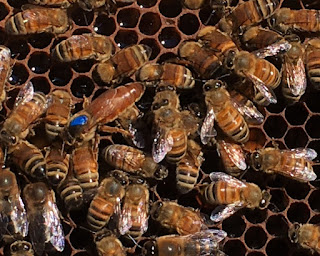Drones are the male reproductive members of the honey bee hive. Drones perform no work in the hive and have but one duty: They mate with queen bees. In the Mid-South, colonies produce queens from April through August, and these queens mate a few days after queens emerge as adults. Since drones serve no purpose to the bees during the winter, colonies drive all drones from the hive in the fall. Removing non-working drones from the hive helps conserve winter food stores and ensure colony survival. There is one instance, though, when drones are not removed from the hive. Queenless colonies often retain their drones through the winter. While making a recent inspection of my hives, I found that most of the drones had been driven from the hives. However, one hive held a number of drones, a situation that calls for further investigation. Normally, beekeepers don’t need to find a queen, only evidence that the colony has one and that she is laying eggs. In today’s photo, we see the queen, a healthy, young queen, marked in blue. This queen was introduced into the hive in late summer, and she is laying plenty of eggs. A number of drones, bees larger than the workers, are visible in the photo.
An important part of our fall hive set-up for winter
involves determining that every hive has enough honey to sustain the colony
through the winter. With decreasing forage available for the bees to make
honey, bees will readily rob honey from any hive if its colony is too weak to
defend itself. Every hive is protected by guard bees that check bees attempting
to enter. Bees not belonging to the colony are rejected by the guards.
Researchers at Washington University in St. Louis found a mechanism for bees
identifying hive mates. See https://phys.org/news/2020-10-gut-bacteria-key-bee-id.html?.
They found that bacteria in the bees’ gut affects the odor of the bees’
exoskeletons. Guard bees identify bees belonging in their hive by their distinct
odor.




